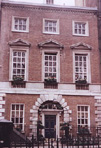
Route & what to see
|
A Mayfair Walk Route & what to see |
| london-footprints.co.uk |
Mayfair, developed in the 18th century by the Grosvenor family, is associated with exclusive shops and houses, which are seen on this walk together with some of the 'service' areas.
This linear walk of about 2 miles begins at Green Park tube station and finishes just off Oxford Street where there are plenty of buses and places for refreshments.
Exit Green Park Station to Piccadilly north side and head west (towards Hyde Park Corner)
Turn right into Half Moon
Street
At the top is the Third Church of Christian Science of 1910-2 and
Trumper’s Barbers
Turn left into Shepherd Market
This was the site of the May Fair which gave the area its name.
It was rebuilt by Edward Shepherd in 1735. Tidy Dols was a seller
of gingerbread who features in a picture by Hogarth.
Wander through the market and
exit into Pitts Head Mews then go right at Derby Street and right
along Curzon Street
There are some fine mid 18th century houses and Crockfords club
at number 30.
Left into Chesterfield Street
There are blue plaques to Beau Brummell and Somerset Maugham. At
the end is a view of the Red Lion pub to the left.
Right along Charles Street and
left at Chesterfield Hill. Right at Hays Mews and right at the
end
Note the curiously named ‘I am the only Running
Footman’ pub
Left at Charles Street and
left into Berkeley Square
There are old houses on west side.
Walk across the square
A central pumphouse of 1800 with a Chinese roof replaces an
equestrain statue of George III.
Go around anti-clockwise,
through the passageway on the north side and right at Bourdon
Street
St George's Buildings were designed by Henry Roberts in 1852-3
and Grosvenor Buildings by RH Burden in 1868-9. There are also
former stables and coach houses. [Booth notebook
entry]
At the end go left along
Grosvenor Street and left at Davies Street. Right at Mount Row,
left along Carpenter Street and right at Mount Street
This area was rebuilt in terracotta and red brick 1880-1900 by
the Duke of Westminster. Notice Allen & Co butchers which has
been trading here since the 1890s. There is an attractive water
feature opposite.
Go left into Mount Street
Gardens
From here can been seen Farm Street Church (home of the English
Jesuits), a school and the Grosvenor Chapel of 1730.
Exit into South Street and go
right then right at South Audley Street
There are interesting shops including Goode’s china, Purdeys
gunsmith and spy shops. Thomas Goode was established in 1827 and
moved to this site in 1845. The premises were rebuilt to the
designs of Ernest George and Peto in 1875-6 and 1889-91. Its
automatic doors are the oldest example still in use. The shop has
wonderful displays including two large Minton elephants in the
window. Purdeys were founded in 1814 and moved to Mayfair in
1881. Their guns, involving hours of craftsmanship, were
originally made on the premises but are now manufactured in
Hammersmith. Also in South Audley Street is the entrance to the
Grosvenor Chapel and a view of the Public Library building of
1895.
At the end go diagonally
across Grosvenor Square
The American Embassy of the 1950s dominates the west side and
there are statues with American connections. On the east side is
a memorial to those killed in the 'Twin Towers' terror attack.
Go right along Brook Street
and right down Avery Row. Go through Lancashire Court to the left
Here is the entrance to the Handel’s House Museum. Brook
Street takes its name from the Tyburn which flows beneath.
Exit into Brook Street and go
across through South Moulton Street
Boldings former sanitaryware factory is now an antiques centre
Go left across to Weighouse
Street
The former King’s Weigh House Chapel is now a Ukranian
Church
Cross Duke Street to Brown
Hart Gardens
The structure in the centre is an electric sub-station which has
a courtyard garden on top.
Go right along Balderton
Street
Flats here belong to the Peabody Trust
Go right at Oxford Street
Opposite is the Selfridges store, opened by American Henry Gordon
Selfridge in 1909. Its eight floors offered six acres of retail
space and 130 departments. The present frontage was completed in
1928 with the large sculpture of The Queen of Time added in 1931.
Go left at Duke Street and
right along Barrett Street into St Christophers Place
Flats here were provided under the work of Octavia Hill
A short walk from here is the Wallace Collection in Manchester Square. Go right to return to Oxford Street opposite Bond Street tube station (Central & Jubilee lines).
london-footprints.co.uk 2012
Reference sources
Walking London - Andrew Duncan
A Prospect of Westminster - Tony Aldous
The Time Out Book of London Walks
London Enclopaedia by Weinreb & Hibbert
The Survey of London Vols 39 & 40 covering Mayfair is available online
[booklist] [Peabody] [places to visit] [walks list]